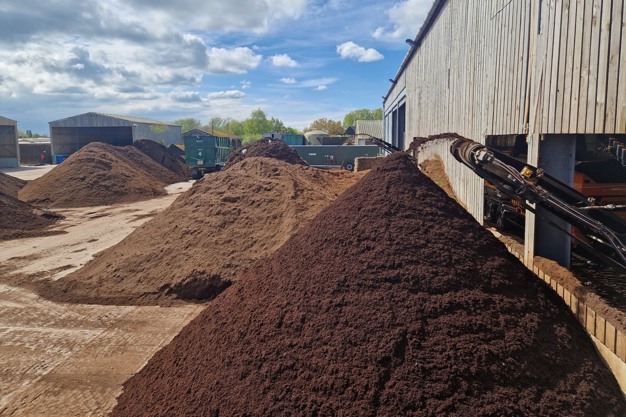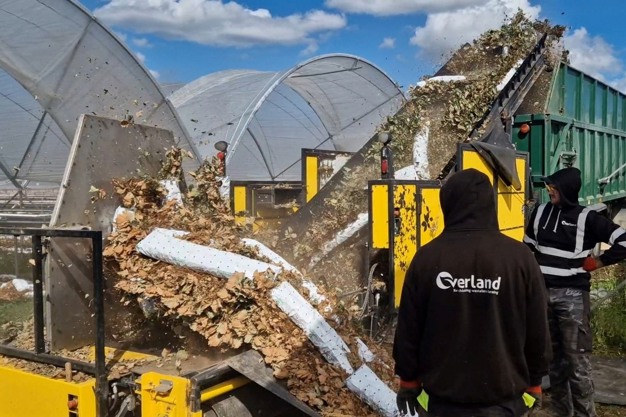Over the past few decades, there has been a major shift from soil to soilless media in U.K. strawberry and raspberry production. With the phasing out of peat, coconut fiber (coir) has become the preferred substrate. Compared to field soils, coir helps growers produce consistently higher yields.
However, increasing demand for coir, limited availability, and volatile shipping expenses have increased growers' costs. The carbon footprint associated with shipping substrate from Asia is also a concern, while additional labor costs are incurred in replacing and disposing of waste coir.
Therefore, the industry has been under increasing pressure to find ways to extend the life of coir. Growers have so far been reluctant to use it for more than a few cropping seasons due to concerns over pest, disease, and weed build-up, which reduces both yields and the quality of the fruit produced. NIAB has been working with Overland Ltd to investigate the potential for reusing strawberry coir substrate.
 The removal of plastic and plant debris leaves clean coir
The removal of plastic and plant debris leaves clean coir
Initial work was done in an EU-funded Interreg project, Horti-blue C, where coir bags used for strawberry production were directly replanted by removing the original plants and planting fresh plants into the same planting holes. It was found that where the coir was devoid of pathogens, June-bearing varieties would tolerate such replanting with little decline in yield.
However, everbearing varieties performed less well, with a yield decline of 6-7% occurring year over year. This is thought to be caused by a reduction in air-filled porosity (AFP) and changes to the chemical and microbial properties of the coir as it gets older.
Overland has subsequently developed an automated process to recycle coir from strawberry bags, which includes automated, low-labor removal of bags from the tunnels, followed by the removal of plastic, plant leaves, roots, and crowns, to leave clean coir.
The coir is then treated in various ways before being made available for growers. Overland funded NIAB to do further work to assess how the cycles of both growing and recycling change coir properties over time. We found that the water-holding capacity increases while the AFP decreases in recycled compared to virgin coir. The extent of this change varied with different coir manufacturers. Changes also occur in pH, electrical conductivity, and nutrient content.
 Automated, low labor removal of bags from the tunnels
Automated, low labor removal of bags from the tunnels
Interestingly, levels of crown rot (Phytophthora cactorum) tend to increase in directly reused and composted coir compared to virgin, but this has not been evident in the fully recycled coir that Overland is producing.
Growing Kent and Medway input
Overland and NIAB secured further funds from Growing Kent & Medway to accelerate the research and bring sustainable recycled coir media into commercial strawberry production. The aims of the project are to develop energy-efficient and robust procedures to eliminate pest, pathogen, and weed risks in recycled material, demonstrate the use of recycled media on a commercial scale, develop wrap-around agronomy advice, and compare lifecycle analysis of the virgin and recycled coir to measure the economic and environmental gains of recycled media.
Results to date
At a commercial site (Kelsey Farms), the everbearing strawberry variety Katrina was planted in virgin Legro coir bags and compared to Overland's recycled coir in bags as well as reused coir (planting directly into used bags). Each of the three coir types was used in nine commercial tunnels (over 3,000 bags per coir type), and irrigation was run independently for each coir type.
Sadly, during harvest, the virgin and reused coir were mistakenly picked and recorded together, so the recycled coir was compared to both virgin and directly replanted coir together. The yields were similar (approximately 1.3 kg per plant), and no differences were found in pests (thrips), weeds, or crown rot pressure between coir types, but there were visual differences in plant growth. In the recycled coir, plants appeared to be stronger and cropped 7-10 days earlier than the virgin coir bags.
The plants grown in recycled media also used 12% less fertigation over the season. This reduction in water use in recycled material was especially prominent during hot days. The grower was very happy with the performance of the recycled media and its management, and the trial has been repeated this season. In 2024, we repeated similar trials comparing the growth of everbearers in recycled coir with virgin coir and also with a 50/50 mix of virgin and recycled coir. This should give growers more confidence in the material while assessing other options.
At NIAB's East Malling site, the everbearing variety Malling™ Supreme was planted in a small trial with both virgin and recycled Legro and Cocogreen coir in troughs rather than bags. Separate irrigation rigs were used for recycled and virgin media but not for each coir brand. The two recycled coirs used 4% less water than virgin. Reduced need for wetting up and maintaining moisture in recycled material at the start of the season was the primary reason, although reduced water use on hot days due to the higher water-holding capacity of the recycled coir also contributed.
The total yield from recycled coir was slightly lower when comparing Legro recycled and virgin coir. This was due to the virgin materials of both brands being fairly comparable in terms of water demand, but recycled materials with different previous growing histories were not.
Namely, recycled Legro material had a much higher water-holding capacity compared to recycled Cocogreen. This meant that recycled Legro coir was over-irrigated and recycled Cocogreen under-irrigated, resulting in a slight yield reduction. It highlights the need for different irrigation/fertigation regimes with different coir types, or at least to use separate valves to manage coir moisture adequately.
In summary, to date, NIAB has demonstrated that recycling coir offers much better potential than either reusing or composting coir, and recycling can achieve strawberry yields and quality that are comparable to virgin material. The rate and level of physical and chemical degradation do vary depending on the coir type, manufacturer, and growing history, but we believe that cost-effective coir recycling is possible with little yield reduction. However, it is important that the irrigation and fertigation of crops grown in recycled coir are managed separately from virgin coir to adjust for the lower AFP in the recycled product; otherwise, over-watering can occur, leading to root death and reduced yield and quality.
Further work is planned to optimize the recycling process to better preserve and improve the physical properties, mitigate any chemical imbalances and residual pests, weeds, and pathogens which might be linked to the slight yield decline. Additionally, the root microbiome of strawberries grown in virgin and recycled coir is being investigated to identify any other microbial imbalances.
An economic and environmental impact analysis of recycling coir will also be carried out and will include total costs and environmental impacts of substrate production/recycling, use on the farm, and disposal.
For more information:
NIAB
info@niab.com
www.niab.com
